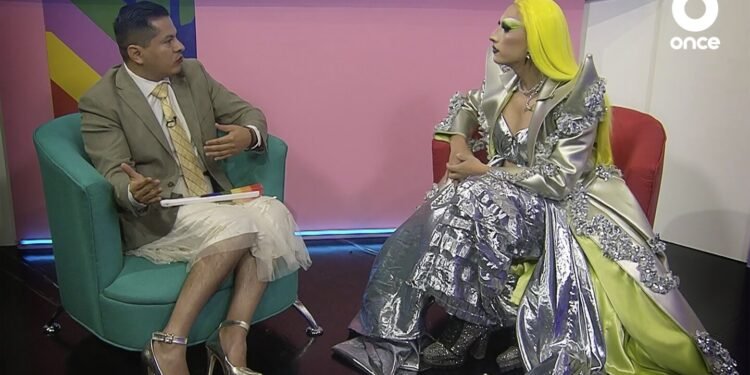MEXICO CITY (news agencies) — Guillermo Barraza buzzes with a nervous energy as he watches himself transform.
Hands delicately paint stripes of bright pink eyeshadow onto Barraza’s angular face as newscasters and makeup crews bustle around him.
Tonight, in a small studio set in the heart of Mexico City, Barraza is making history.
Through his drag character Amanda, the 32-year-old journalist is the first-ever drag queen to host a news program for Mexican TV.
By stepping out under the glow of the studio lights, Barraza has sought to push the boundaries of society in a place where both LGBTQ+ people and journalists are violently targeted. And he is doing it at a moment when the issue has roared back into the public discourse with the violent death of one of the very guests on his program, one of the most prominent queer figures in the country who was later found dead along with their partner with dozens of cuts across their body.
“Having an alter ego, you have fewer problems because they can’t harass a character. You have more freedom to speak out,” he said. “There are many things that Guillermo wouldn’t do or say that Amanda wouldn’t think twice about.”
As he says it, his makeup artist helps him pull on a bright blonde wig, and Barraza shrugs on a purple sequined blazer. Each piece goes on like another layer of sparkle-studded armor until all that remains of Barraza is a playful smile under purple lipstick.
“Let’s go, let’s go,” Barraza says, striding through the halls, each clack of his leather boots ringing out like an act of defiance to a society that has long rejected people like him.
“Rock star,” he adds, pushing through the heavy metal doors and onto his set.
From its inception, the program “La Verdrag” was meant to radically transform the way the LGBTQ+ communit y is viewed in Mexican society. First broadcast in October, the program goes against the grain in a highly “macho” country where nearly 4 in every 5 people identify as Catholic.
The program — a play on words in Spanish mixing the word “truth” and “drag” — first came to fruition when Barraza, a journalist of 10 years, took the helm of the newscast of his public television station, Canal Once, during Mexico’s Pride celebration in June dressed in drag.
The crush of hate comments that followed first scared Barraza, who had already received two death threats working as a journalist in northern Mexico. But it soon pushed him and the TV station to create a show to make a space to discuss LGBTQ+ issues with a serious tone.
“This just years ago, would be completely unthinkable, talking about transsexuality, gender, drag,” said Vianey Fernández, a news director at Canal Once. “We want to open up spaces for the LGBTQ+ community, and we need to do it with a serious perspective, recognizing not just their rights but also their abilities.”
In Mexico, drag — the act of dressing up in exaggerated outfits that challenge gender stereotypes — has been long employed in entertainment and comedy shows like “El Show de Francis,” “Las Hermanas Vampiras” and “Desde Gayola.”
The shows would often use gay slurs and cartoon-like stereotypes. Still, they took key steps in carving out space for the queer community in Mexico, said Jair Martínez, researcher for the Mexican LGBTQ+ rights organization Letra S.
“They’re pioneers, showing how you can transform yourself from a victim to someone with agency, with the capacity to resist,” he said.
Growing up gay in the hyper-conservative northern city of Culiacán, Sinaloa, Barraza never saw gay characters he identified with on a deeper level staring back at him from the screen of his family’s clunky television.
On news channels, the only time gay people were brought up was following a hate crime or a brutal murder. In school, people would go out of their way to not appear gay. With a family that continues to struggle to accept his public gender expression, Barraza said he only grew into himself when he became involved in a theater community, where his character of Amanda was born.
“In Sinaloa, they teach you not to be gay.” Barraza said. “Historically, we were always ridiculed, an object of entertainment.”
In other countries, with the rise of shows like “RuPaul’s Drag Race,” drag has gradually mixed with mainstream culture. But drag has long been used as a tool or resistance when the LGBTQ+ community is “under attack”, explained Michael Moncrieff, a University of Geneva researcher who has studied the history of drag queens.



 Pakistan Rupee Exchange Rate
Pakistan Rupee Exchange Rate





